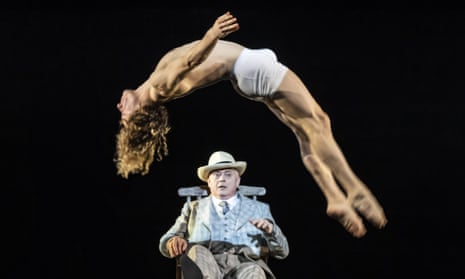Hope ends in death. That thought tinges every bar of Benjamin Britten’s Death in Venice (1973), in which an ageing writer, Gustav von Aschenbach, has impossible desires for a beautiful boy to whom he never speaks. Fantasies breed like weevils in his soul. As Venice succumbs to an outbreak of cholera, he pictures himself and the boy being lone survivors. Still yearning, still chasing his lost youth, now with hair dyed and cheeks rouged, Aschenbach dies. (Given the work’s title I will risk the spoiler.)
With its 17 rapidly changing scenes, large cast and virtuosic orchestra, the opera – its subject matter also famous from Visconti’s 1971 film – poses challenges in the theatre. Much was riding on Welsh National Opera’s first production of the work, directed by Olivia Fuchs, conducted by Leo Hussain, in a collaboration with the Cardiff-based NoFit State circus company. Collectively and individually, they have triumphed. At a time of crisis and scrutiny for UK opera, this stands as an exemplar.
Every problem has been solved, with first-class musical standards and a staging of bold imagination. The astute choice of Mark Le Brocq as Aschenbach alone would have carried the show. This versatile and reliable British tenor has taken so many roles of every scale and kind over the years, his gifts may have been taken for granted. Vocally secure throughout (he is rarely off stage), he acts with courageous stillness and nuance, emphasising his character’s inner conflict and frailty.
Written as Britten (1913-76) was confronting his own mortality – his heart condition was beyond treatment – Death in Venice blazes, troubles, beguiles. At times, in the pathos of its portrayal of blameless human folly, it repulses. Britten, whose necessarily repressed fascination with adolescent boys is well recorded, poured everything into this final opera, to a libretto by Myfanwy Piper based on Thomas Mann’s novella. What must it have taken the ailing Britten to have completed a work of such raw intensity? He wanted it to be the best thing he had ever done, and in its restless, uncomfortable way it is. In her programme note, Fuchs quotes Britten’s partner, Peter Pears, for whom Aschenbach was written, saying: “Ben is writing an evil opera, and it is killing him.”
Musically the score outstrips the composer’s own prodigal brilliance, showing his mastery of new forms and colours. Rampant with spangling harp, lugubrious, nimble bassoon, solo piano, it finds especially distinctive expression in the use of the gamelan, that glittering, percussive Balinese visitor. Hussain draws together all the musical elements with pace and rigour, in the pit and on stage.

An excellent ensemble cast, full of lively cameos, is led by the baritone Roderick Williams, who delights in shape-shifting between several roles, as assigned by Britten, from sleazy fop to Charon-like gondolier, steering Aschenbach across the Styx-like inky lagoon. The countertenor Alexander Chance, as the gold-suited Voice of Apollo, shone visually and vocally.
Fuchs’s coup is to replace the usual dancers, for the boy Tadzio and his family, with the acrobats of NoFit State. Their breathtaking, somersaulting routines, however compelling, never distract from Britten’s music. The Belgian performer Antony César, looking like a grown-up version of Björn Andrésen, who found fame in Visconti’s film, is an ideal Tadzio. Nicola Turner keeps her handsome designs simple: essentially a black box with sensuous monochrome images of Venice (video by Sam Sharples) and lighting by Robbie Butler. The Edwardian mood of the original is maintained, with Tadzio in sailor suit, his family in white with parasols. The show is on tour until mid May. If I can get to it again, I will.
Bells, specifically the unearthly toll of St Mark’s, are a central musical motif in Death in Venice. In a higher, more urgent mode they also feature in the soundworld of Giant, by Sarah Angliss to a libretto by Ross Sutherland. First seen in Aldeburgh last year, this short work, part spoken, has now had its London premiere, directed by Sarah Fahie, at the Royal Opera House’s Linbury theatre. Its subjects are the 18th-century Scottish surgeon-collector John Hunter and the “Irish Giant” Charles Byrne, who achieved unwonted celebrity by growing to the immense height of 7 feet 7 inches.

Knowing Byrne’s life would be short, Hunter secured his corpse, deviously, for his otherwise admirable scientific purposes. Karim Sulayman in the title role and Jonathan Gunthorpe as Hunter led the six-strong cast. Angliss’s score, deftly conducted by Ben Smith and dominated by viola da gamba, recorder, theremin and electronics, provides an entrancing if undramatic meditation on the complex morality of this tale.
The pianist Angela Hewitt stepped away from her usual high-profile international platform to perform with Fidelio Orchestra – a symphony orchestra created to help launch the careers of musicians starting out, but also sprinkled with non-professional players – in St Andrew’s church, Holborn. After a lithe account of JS Bach’s Concerto in D minor, BWV 1052, which she directed from the piano, Hewitt played Brahms’s early, mighty Concerto No 1 in D minor, Op 15, conducted by Raffaello Morales, the orchestra’s founder.
Hearing a repertoire piece such as this in more intimate circumstances brought fresh rewards, but the importance here was Fidelio Orchestra’s aim: to give musicians of the future a chance to make music with the world’s leading performers, in events open to all. They do. With tickets only £15 or £30, this is an enterprise worth our support. Next concert: Mahler’s Symphony No 6, 15 June, at LSO St Luke’s.
Star ratings (out of five)
Death in Venice ★★★★★
Giant ★★★
Angela Hewitt ★★★★
Death in Venice tours to Southampton (20 March), Oxford (26 March), Bristol (27 April) and Birmingham (11 May)

Comments (…)
Sign in or create your Guardian account to join the discussion